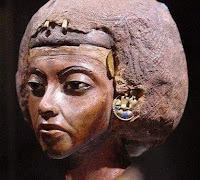Dürer, French Drawings and the Stages of Life
Albrecht Dürer , The Head of Christ , 1506 brush and gray ink, gray wash, heightened with white on blue paper overall: 27.3 x 21 cm (10 3/4 x 8 1/4 in.) overall (framed): 50 63.8 4.1 cm (19 11/16 25 1/8 1 5/8 in.) Albertina, Vienna The National Gallery of Art is hosting the largest show of Albrecht Dürer drawings, prints and watercolors ever seen in North America, combining its own collection with that of the Albertina in Vienna, Austria. Across the street in the museum's west wing is the another exhibition of works on paper, Color, Line and Light: French Drawings Watercolors and Pastels from Delacroix to Signac . The French drawings are spectacular, but it's hard to imagine the 19th century masters without the earlier genius out of Germany, Dürer, who approached drawing with scientist's curiosity for understanding nature. Albrecht Dürer, Self-Portrait at Thirteen , 1484 silverpoint on prepared paper, 27.3 19.5 cm (10 3/4 7 11/16 in.) (framed): 51.7 43.1 4.5 cm (20 3/8 16...





Comments
Post a Comment